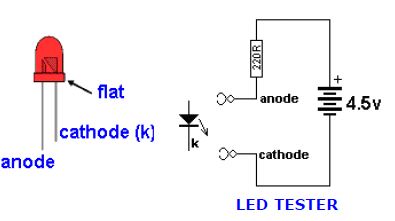Light Emitting Diodes (LEDs) are diodes that produce light when current flows from
anode to cathode. The LED does not emit light when it is revered-biased. It is used as
a low current indicator in many types of consumer and industrial equipment, such as
monitors, TV’s, printers, hi-fi systems, machinery and control panels.
The light produced by a LED can be visible, such as red, green, yellow or white. It can
also be invisible and these LEDs are called Infrared LEDs. They are used in remote
controls and to see if they are working, you need to point a digital camera at the LED
and view the picture on the camera screen.
An LED needs about 2v - 3.6v across its leads to make it emit light, but this voltage
must be exact for the type and colour of the LED. The simplest way to deliver the
exact voltage is to have a supply that is higher than needed and include a voltagedropping
resistor. The value of the resistor must be selected so the current is between
2mA and 25mA.
The cathode of the LED is identified by a flat on the side of the LED. The life
expectancy of a LED is about 100,000 hours. LEDs rarely fail but they are very
sensitive to heat and they must be soldered and de-soldered quickly. They are one of
the most heat-sensitive components.
Light emitting diodes cannot be tested with most multimeters because the
characteristic voltage across them is higher than the voltage of the battery in the
meter.
However a simple tester can be made by joining 3 cells together with a 220R resistor
and 2 alligator clips:
LED TESTER
Connect the clips to a LED and it will illuminate in only one direction.
The colour of the LED will determine the voltage across it. You can measure this
voltage if you want to match two or more LEDs for identical operation.
Red LEDs are generally 1.7v to 1.9v. - depending on the quality such as "high-bright"
Green LEDs are 1.9v to 2.3v.
Orange LEDs are about 2.3v and
White LEDs and IR LEDs are about 3.3v to 3.6v.
The illumination produced by a LED is determined by the quality of the crystal. It is the
crystal that produces the colour and you need to replace a LED with the same quality
to achieve the same illumination.
Never connect a LED across a battery (such as 6v or 9v), as it will be instantly
damaged. You must have a resistor in series with the LED to limit the current.

No comments:
Post a Comment